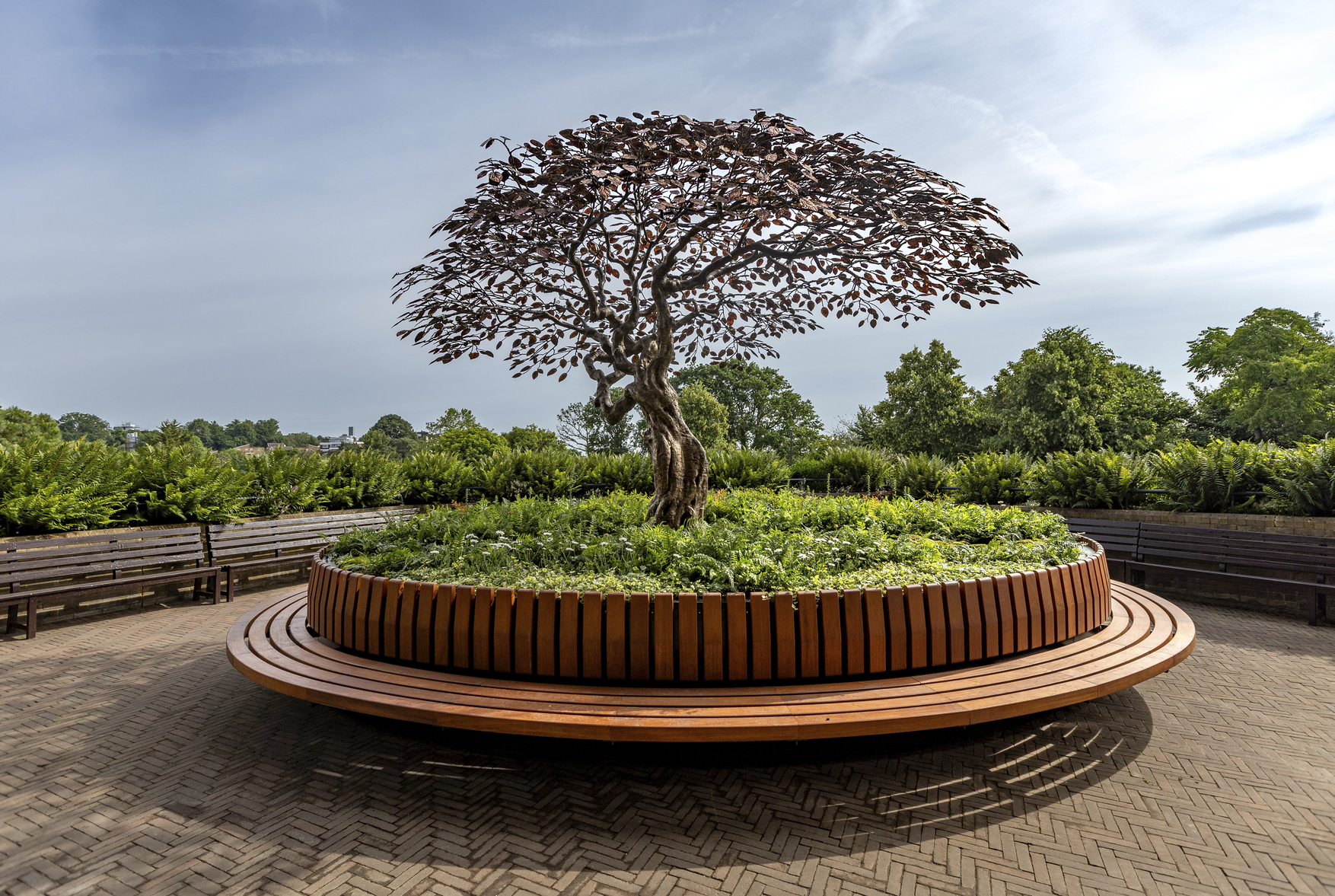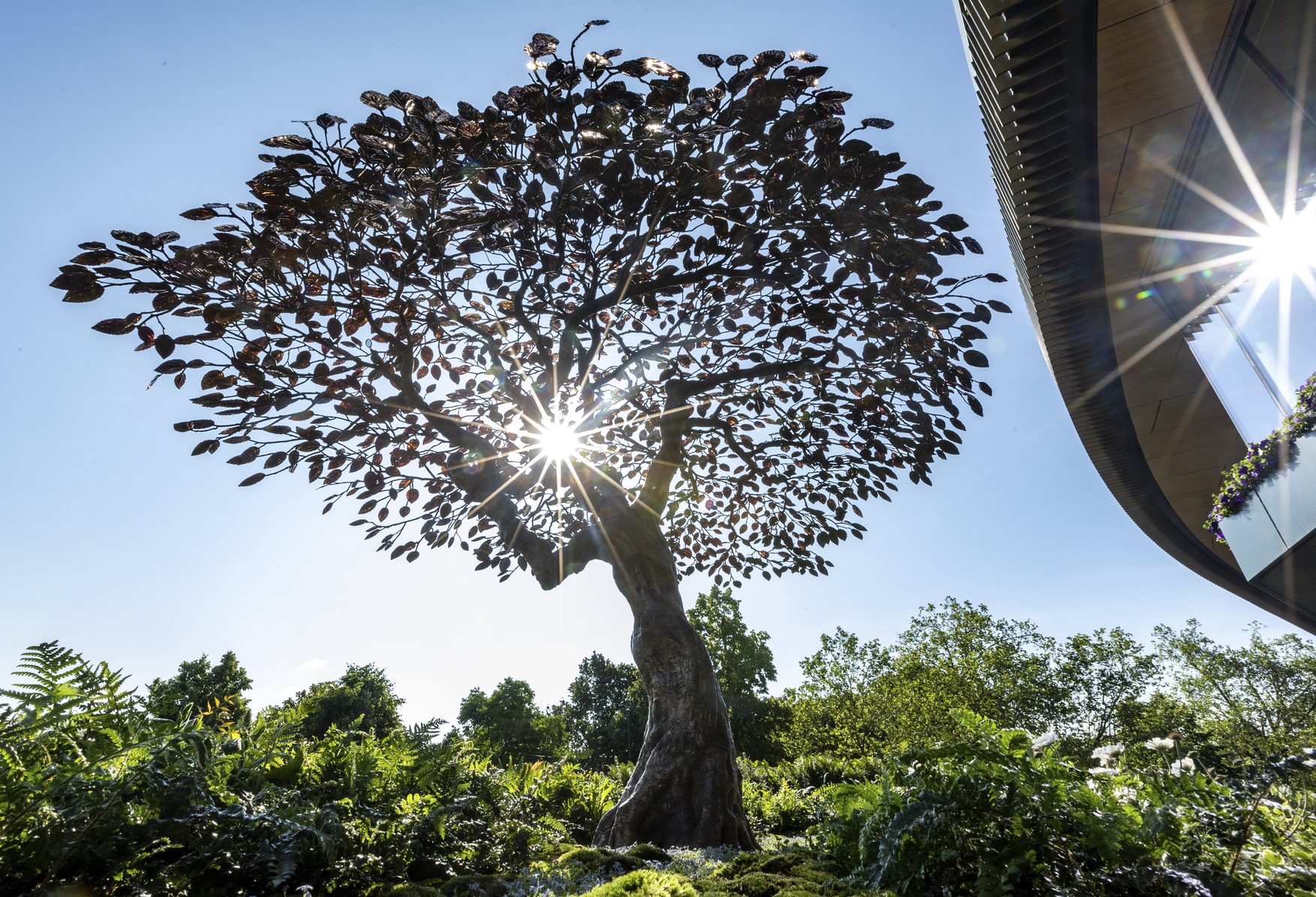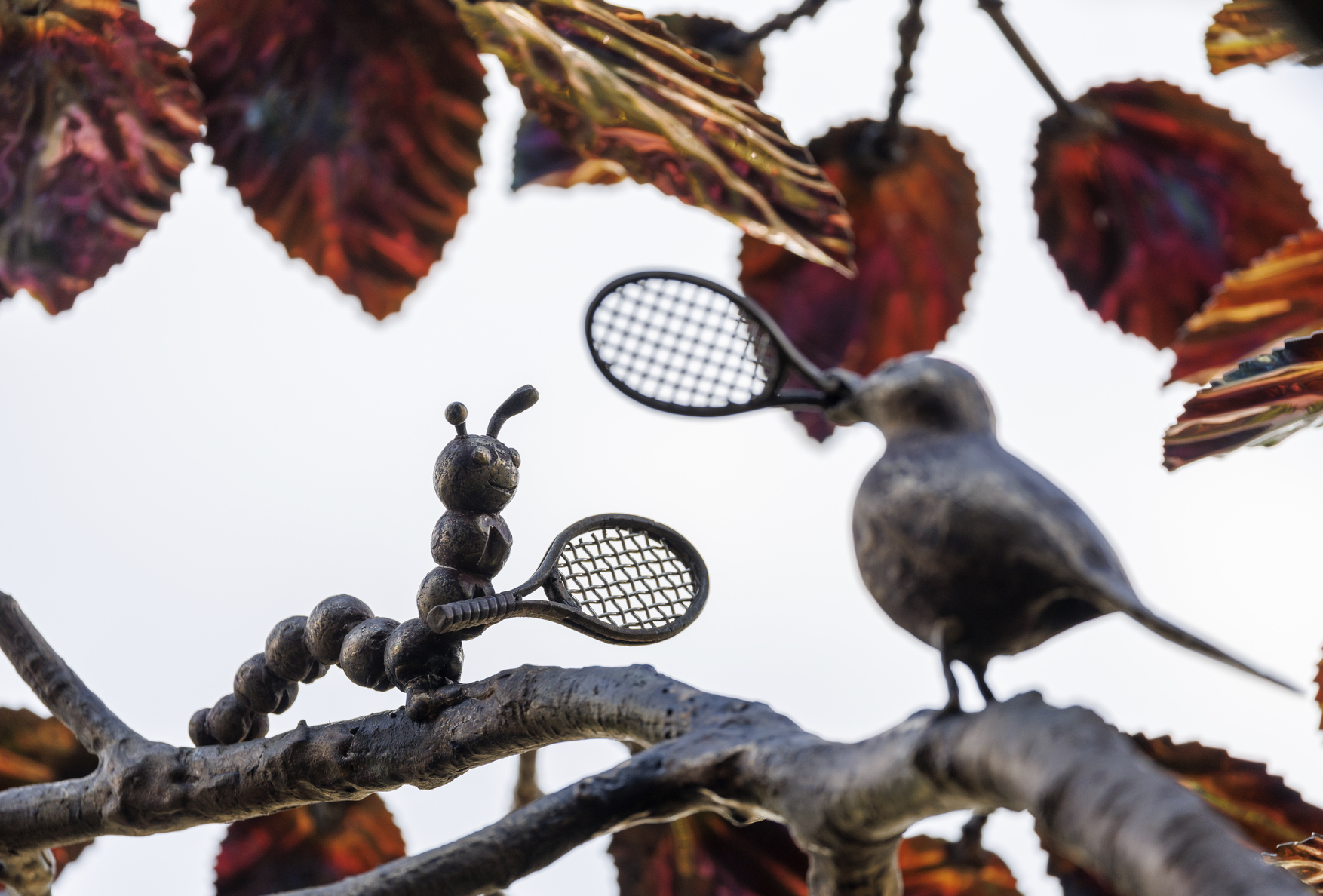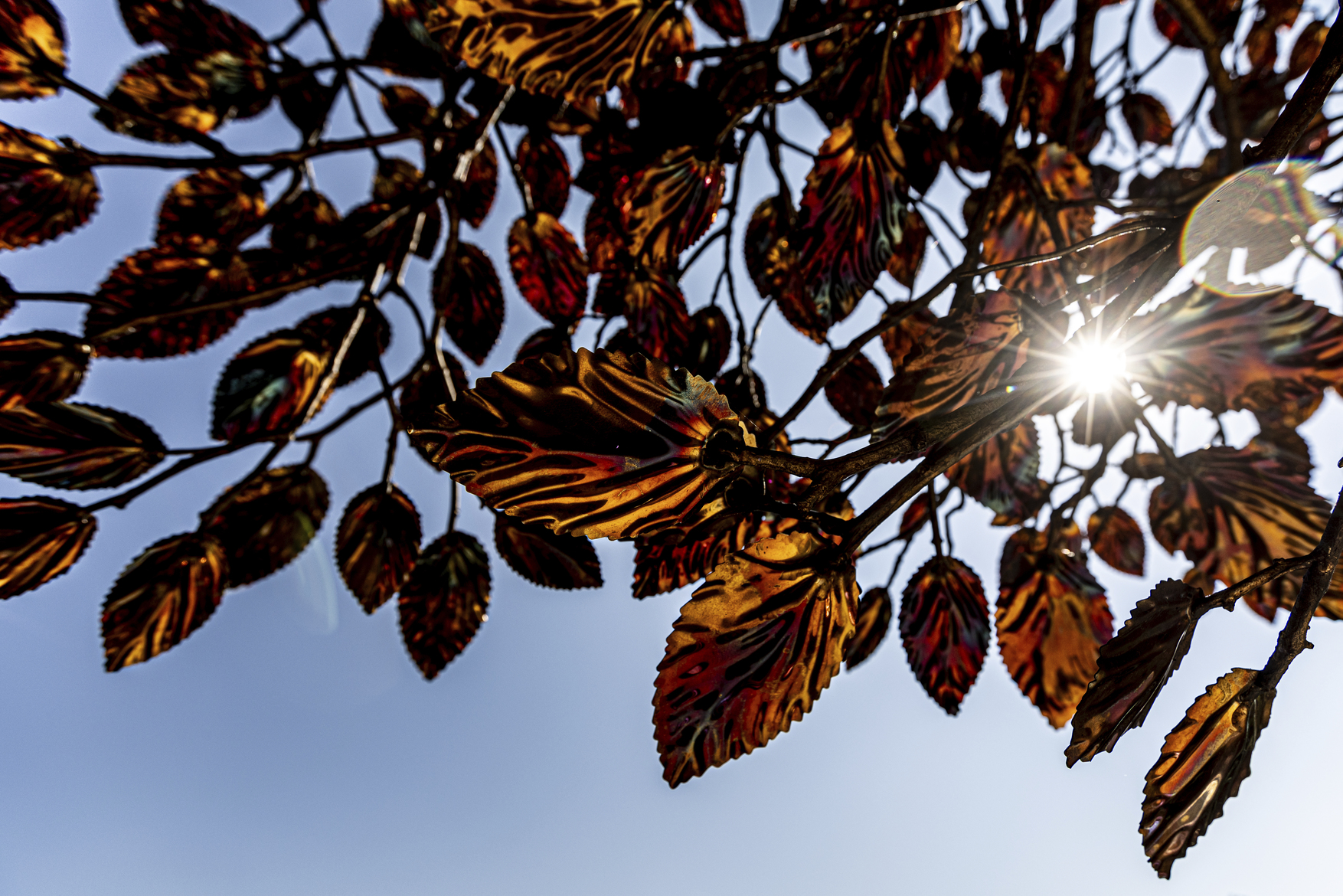Bronze
Dimensions: 3.55m tall, 3.75m wide, 5m deep

View of The Serving Ace Meeting Tree by sculptor Mark Reed ahead of The Championships 2023. Held at The All England Lawn Tennis Club, Wimbledon. Day -10 Friday 23/06/2023. Credit: AELTC/Chloe Knott.
The genesis of the Serving Ace Tree sculpture was initiated from AELTC’s Head Gardener – Martyn Falconer who enquired about the possibility of a tree sculpture as a meeting tree for the Championships.
This started the creative process in which I felt impassioned to combine an aspect of tennis and a tree.
I was invited to the Championships to watch the game live, and I immediately knew I wanted to try to capture some of the power of the serve. The tennis player seems to stop time-they are prepared and in position, like a drawn bow… silence and peace… they have a lightness, as if levitating in the air, defying gravity with their arm raised…. before they explode the ball down the court. The form of tree that seemed perfect to express this was the windswept tree that has such directional movement in it. So, I made a maquette out of wire and clay and sent it to AELTC and thankfully they embraced it with great excitement.
This started my imagination on a journey to combine the power of a serve and a sculptural tree. It fascinates me how this position has so much tension in the moment and yet is perpendicular to the direction of serve, so I made the androgynous human form in the trunk at right angles to the direction of the flow of the windswept canopy with movement and muscles characterised in the trunk and branches. I twisted the limbs on the other side to symbolise a racquet that comes into view only in certain positions as one moves around the tree. The left serving arm holding the ball, is thrust vertically upwards, the hand open is represented by the horizontal branches that flow out of the vertical limb, the canopy of the windswept tree form allows for this to be explored capturing the energy of the direction of force and focus, with the tree ‘serving ‘towards Centre Court.
Trees are intrinsic to all life on earth and the tree symbolises both their life sustaining powers and the effects they have on our physical and mental wellbeing. In its position outside Court Number 1, the work invites the viewer to think about the oasis of green that is the AELTC and its environs and a celebration of the intense energy of the elite tennis player primed and ready to explode the ball to their opponent. From a distance, it is the tree that is most evident, but as one moves closer, the figure becomes more pronounced. Furthermore, as the spectator circles the sculpture masculine and feminine body forms emerge and fade from tree to figure and back again.
There are more discoveries within the canopy, as 2 arch enemies in the form of a bird and caterpillar play a game of tennis overseen by a watchful owl umpire and a squirrel ballboy, along with an engraved leaf to commemorate the Coronation of King Charles III.
I am immensely grateful to The All England Lawn Tennis Club for the opportunity to create the Serving Ace Tree who have been absorbed by the whole concept from inception, through maquette to the final piece and none of this would have been possible without Andrew Wayro- Senior Landscape Design Manager, who nurtured this sculpture from beginning to end.
Facts and figures
- The sculpture utilised 1.4 tonnes of bronze.
- There are over 1900 marine grade stainless steel Beech leaves, patinated with a myriad of colours ranging from copper, bronze, pinks to purple. The leaves shimmer and catch the light beautifully.
- A wire metal frame was created to hold the tonne of clay that Mark Reed used in the piece, and the wire figure was in the proportion of a 6’2” frame (the average height of a male tennis player).
- The master was sculpted in clay and utilised over 1 tonne of the material. Mark sculpted and resculpted the piece to achieve his aim of incorporating the muscular form within the gnarled features and bark of the beech tree trunk and branches.
- Sculpting the master took over 384-man hours with Mark and an assistant working upon it.
- Mark had to sculpt the clay master, then take a mould of it in silicone from which we could make a wax copy. This wax copy was covered in the ceramic shell into which the bronze would be finally poured.
- One of the longest jobs was creating the lost wax moulds for the branches, which involved casting each branch in wax, then creating a ceramic shell by over dipping it in liquid ceramic in layer after layer, then the wax is burnt out creating a perfect replica of the branch inside, which is to be cast in bronze, this section of the tree alone took over 1500 hours. The leaves were laser cut and then pressed by hand on a fly press in the which created their distinctive Beech leaf shapes.
- Once the branches were cast, we had to weld all the leaves on, this is a complicated procedure as it is welding marine grade stainless steel to bronze. The next process was casting the waxes for the larger branches that formed the body of the tree and the distinctive ‘serving ace shape’.
- Mark then created the patterns in silicone and then fibre glass for all the larger branches of the tree.
- We cast all the bronzes in our own studio, and this was achieved by Mark and another assistant, at this point it’s wonderful to see the piece begin to form, albeit in small sections. Overall, we cast over 1000 small branches, as a certain percentage fail, so we had to make sure that we overcompensated for any failures. The way that lost wax casting works, the piece is created in wax, then burnt out and then created in the bronze, once the outer ceramic shell is smashed off, if it has failed, then the entire process needs to be started from scratch again.
- The next process was polishing each branch and patinating it to achieve the desired finish before Mark could begin work on welding the entire tree together. Mark says that the “essential art of observation of the patterns and forms within nature are engrained on my memory from my childhood growing up on a Fruit farm in rural East Anglia” with this piece he was immersed in the spirit of the tree and the emotion and energy in the elite tennis player, both striving to achieve growth and championship over others around them. Reed in this piece combined the spirit in nature, both plant and human, incorporating movement and emotion within the work.
- Reed is delighted and honoured that AELTC will be unveiling the work for the 2023, coinciding with the year of King Charles III Coronation. This is especially poignant as Mark originally set up his studio with the assistance of a Princes’ Youth Business Trust Grant, so, in essence, the Serving Ace Meeting Tree’ and his entire artistic journey would not have been possible without the King and his Trust.
- In total the artwork has taken over 5,900-man hours by Mark with the assistance of 6 members of his team including his wife, Hannah, 2 fine art students from the Norwich University of Arts and 3 of his 4 children, (the youngest looked after the dogs while we were all in the studio).
Read about the tree in the New York Times:

See more information on the Wimbledon website here.

View of The Serving Ace Meeting Tree by sculptor Mark Reed ahead of The Championships 2023. Held at The All England Lawn Tennis Club, Wimbledon. Day -12 Wednesday 21/06/2023. Credit: AELTC/Chloe Knott.

Detail of a decorative sculpture of a worm and a bird on The Serving Ace Meeting Tree by sculptor Mark Reed ahead of The Championships 2023. Held at The All England Lawn Tennis Club, Wimbledon. Day -11 Thursday 22/06/2023. Credit: AELTC/Chloe Knott.

Detail of the Serving Ace Meeting Tree by sculptor Mark Reed ahead of The Championships 2023. Held at The All England Lawn Tennis Club, Wimbledon. Day -19 Wednesday 14/06/2023. Credit: AELTC/Chloe Knott.

Detail of the Serving Ace Meeting Tree by sculptor Mark Reed ahead of The Championships 2023. Held at The All England Lawn Tennis Club, Wimbledon. Day -19 Wednesday 14/06/2023. Credit: AELTC/Chloe Knott.

View of The Serving Ace Meeting Tree by sculptor Mark Reed ahead of The Championships 2023. Held at The All England Lawn Tennis Club, Wimbledon. Day -12 Wednesday 21/06/2023. Credit: AELTC/Chloe Knott.
